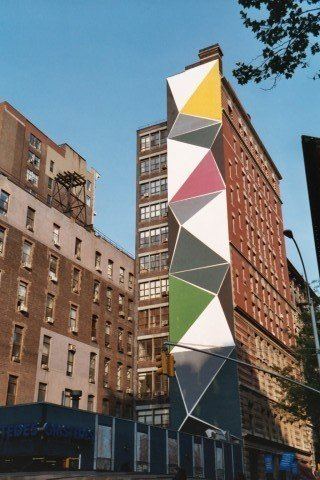Full Name Tatiana Lewin Nationality Polish-American Name Tania Tania | Role Artist Died January 24, 1982 | |
 | ||
Known for painting, sculpture, collage, wall painting Periods Geometric abstraction, Hard-edge painting, Public art, Pop art | ||
Makeup artist tania
Tania (1920, Warsaw, Poland, Tatiana Lewin – 1982, Brooklyn, New York) was a Polish-born, New York based, Jewish American abstract painter, sculptor, collage artist, and painter of city walls. She was known by several different married names over the course of her career (including Tania Pollak, Tania Milicevic, Tania Schreiber, Tania Schreiber-Milicevic, Tania Milicevic-Mills, and Tania Mills), but decided as of 1958 to use simply her first name, Tania. She was active in the New York art world from 1949 to 1982, but is perhaps best known for her 13-story geometric wall painting of 1970, which still stands at the corner of Mercer St. & 3rd St. in Greenwich Village, New York. In 1966, she became a founding member of City Walls, Inc., a non-profit organization that commissioned abstract artists to paint walls around New York City, and which (when consolidated with the Public Arts Council in 1977) would later become the Public Art Fund.
Contents
Makeup artist tania
Early life and education
Tania was born in 1920 in Warsaw, Poland, to Mischa (Michael) and Rosalia (Rose) Lewin. Around 1931, the family emigrated to Paris, where Tania spent the rest of her childhood. The family fled to Montréal, Canada in 1941 following Germany's invasion of France. There, Tania received a Master of Arts from McGill University before relocating to New York City with her parents in 1943. She began a PhD in French Literature at Columbia University, but left the program with ABD status. In 1949, she began courses at the Art Students League of New York, where she studied painting with Yasuo Kuniyoshi, Morris Kantor, and Vaclav Vytlacil.
Career
Over the course of her career, Tania worked in a number of styles before settling on her characteristic geometric abstract style featuring hard-edged triangles. Her early paintings from the late 1940s evidence the influence of her teacher Yasuo Kuniyoshi, both in terms of their subject matter and color palette. In her student years, she exhibited in juried student exhibitions at the Art Students' League. In 1951, she was included in a group show of newcomers at the Creative Gallery. From 1954-58, she made a living designing wallpaper, fabrics, and carpets while raising her young children.
Tania had her first "one-man show" at Albert Landry Gallery in 1959. She asked Ad Reinhardt to help her hang the show. Through the early 1960s, she worked primarily in collage and assemblage. This phase featured abstract collages of corrugated cardboard and paint as well as more heavily Pop-influenced collages and wood assemblages featuring signage, advertising, and other found materials. She exhibited several of these colorful wood sculptures in her 1963 solo show at Bertha Schaefer Gallery under the name "Color Structures." During this time, Tania also exhibited what she called her "complementary paintings," works comprising two abutted canvases. These "complementary" (or "binary" works) typically combined collaged canvases with monochrome ones. In a related set of works on paper, she mounted collages opposite her own poetry in French. Her 1961 show at Landry Gallery included complementary paintings and corrugated board collages, but also several large-scale "environments." In 1962, she was sponsored by Ad Reinhardt, Philip Pearlstein and Pandolfini and elected as a member of the The Artists' Club. She began teaching at New York University in 1963.
Two drawings housed in the collection of the Metropolitan Museum of Art show that Tania had arrived at her geometric style at least by 1967. She produced paintings and prints featuring variations on her characteristic "overlapping triangles" composition. In this period, she also produced large-scale aluminum sculptures that translated the overlapping triangles composition into multi-planar, three-dimensional form. Examples of this type of sculpture can be seen in the Kingsborough Community College Marine & Academic Center building in Brooklyn and on the library at Albright College in Reading, PA. In a statement from 1978, Tania likened her triangles to rooftops, seen from above: "For a few years now I have been thinking of my paintings (always executed on the floor) as roof tops seen from the air - in the clouds - in the sun - in the night. The paintings have become sketches for buildings planned from the top down...The Spiral Jetty of Smithson could be done in the City."
From roughly 1966, when she co-founded City Walls Inc., Tania had begun to devote much of her energy to public and outdoor art projects. With the sponsorship of City Walls, she painted walls at Evergreen & Weirfield Aves in Brooklyn (1968), Bryant & Lafayette Aves in the Bronx (1968), and at Mercer & 3rd St. in Manhattan (1970), but only the Manhattan wall remains. In 1972, she collaborated with Nassos Daphnis to produce a temporary "environment in process" by painting various surfaces at the construction site of a high-rise in Times Square—from the building's skeleton (Daphnis), to the surrounding plywood scaffolding, to construction workers' shoes and toolboxes.
Tania commented in her writings about the difficulty of being a woman artist who painted geometric abstractions. In one unpublished autobiographical text she writes, "My paintings were 'too large for a woman,' said the New York Times ...I painted like a man... I guess I was supposed to paint flowers."
Select Exhibitions
Collections
Tania's works can be found in the following public collections:
She also designed doors for a Torah ark (1966–67) that is still in use at the White Street Synagogue (or Synagogue for the Arts) in New York.
